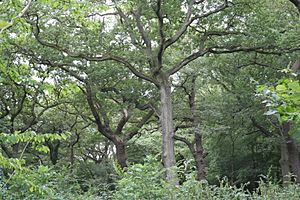Queen's Wood facts for kids
Queen's Wood is a beautiful 52-acre (21 hectare) area of very old forest in London. It's located in the London Borough of Haringey, right next to Highgate Wood. You can find it between the areas of East Finchley, Highgate, Muswell Hill, and Crouch End. This wood was once part of a huge ancient forest called the Forest of Middlesex, which covered a lot of London and nearby counties. Queen's Wood is so old that it was even mentioned in the Domesday Book, a famous survey from over 900 years ago! Today, it's one of three special Local Nature Reserves in Haringey, meaning it's protected for its wildlife and plants. It's also super easy to visit, just a short walk from Highgate tube station.
Contents
Discover Queen's Wood's History
Queen's Wood has a long and interesting past. The Haringey area is home to four ancient woods. These include Highgate Wood, Queen's Wood, Coldfall Wood, and Bluebell Wood. All of these old forests appear on a map made by John Rocque in 1754.
How Queen's Wood Got Its Name
This special wood was once known by a different name: Churchyard Bottom Wood. It was originally part of the much larger Great Forest of Middlesex. In 1898, the local council, then called Hornsey Urban District Council, bought the wood. It was officially opened to the public by Princess Helena, Duchess of Albany. To honor Queen Victoria, the wood was renamed Queen's Wood.
Plants and Animals of Queen's Wood
Queen's Wood is an ancient forest filled with many types of trees and plants. It's mainly an oak and hornbeam woodland. You'll find tall English oaks and some beech trees forming a leafy roof. Below them, there are smaller trees like cherry, field maple, hazel, holly, and hornbeam. You might also spot hawthorn and mountain ash, along with two kinds of birch trees. A rare tree called the Wild Service Tree also grows here. Its presence is a sign of how truly ancient this wood is!
Rich Plant Life
Even though it's close to central London, Queen's Wood has an amazing variety of ground plants. This is called its flora. You can see many beautiful wood anemone flowers, goldilocks buttercup, and wood sorrel. Other plants include yellow pimpernel and square-stemmed St John's wort. A study in 1984 found 39 different types of herbaceous plants and 15 kinds of grasses native to the wood. Plus, there were 23 different species of trees and shrubs!
Wildlife in the Wood
Queen's Wood is a great place for wildlife, even with people visiting often. The bird life is very varied, and you can even spot three different types of woodpeckers! Over 100 kinds of spiders have been found here. There's also a nationally rare jewel beetle that lives throughout the wood.
From Pool to Pond
A small paddling pool that was no longer used has been turned into a lovely pond. This pond is now home to many wild aquatic plants. This project was completed with the help of a group called the Friends of Queens Wood society.
Queen's Wood and the River Moselle
This park is also the starting point for the Moselle. This is a small stream that flows across parts of North London. Today, it connects to the Pymmes Brook and eventually joins the River Lea in Tottenham.
Protecting Queen's Wood
Queen's Wood is a very important natural area. It is officially a Local Nature Reserve. It's also recognized as a Site of Metropolitan Importance for Nature Conservation. This means it's one of the most important places in London for nature. Unlike some other woods, Queen's Wood has not been managed too much. This has allowed it to keep a greater variety of plants and animals. For example, more ground-feeding birds live here compared to Highgate Wood. This is because Queen's Wood has more diverse plant layers and a denser shrub layer, which provides better homes for them.


